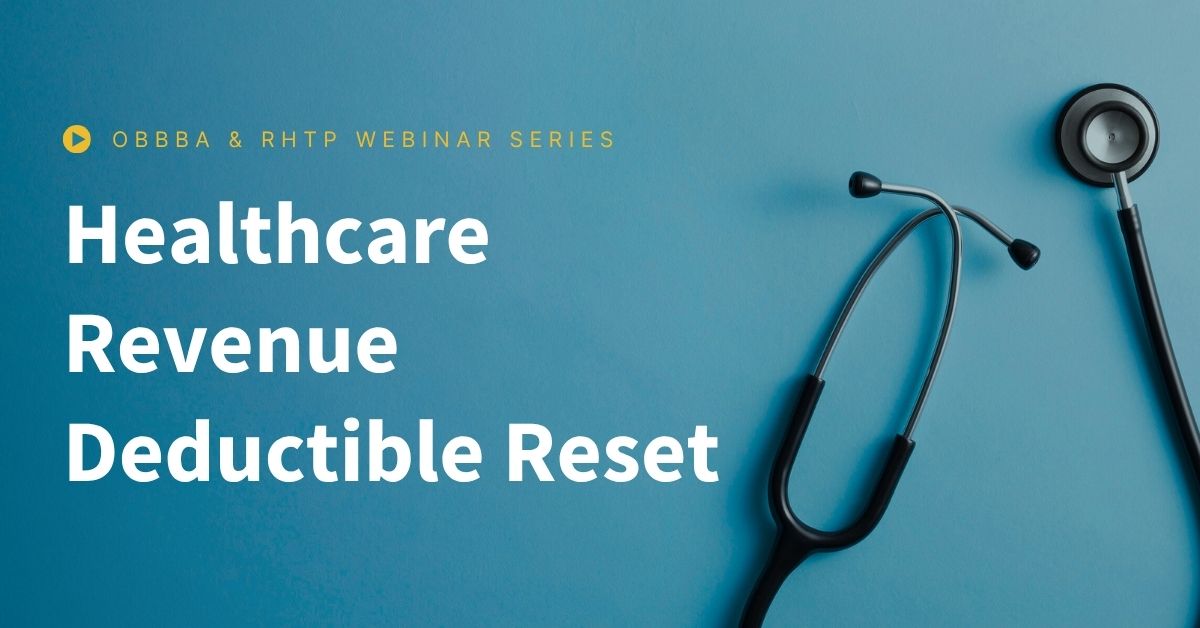OBBBA Medicaid Impact: Strategies for Rural Healthcare
The One Big Beautiful Bill Act (OBBBA) will hurt rural healthcare by hurting rural Medicaid recipients. It’s estimated that the OBBBA Medicaid impact on rural areas will result in up to 2.7 million people losing Medicaid and Affordable Care Act (ACA) coverage by 2034.1
While the Rural Health Transformation (RHT) Program may help by infusing up to $200 million in funding to each state between 2026 and 2030, it won’t be enough.
This article shares strategies presented in the How to Mitigate OBBBA Impacts with Added Roles and Services webinar. Ideas discussed include those to help rural hospitals and rural healthcare clinics navigate OBBBA Medicaid and other impacts by:
- Adding functional roles
- Diversifying services
- Shifting to a value-based care model
Adding Functional Roles to Minimize OBBBA Medicaid Impacts
It sounds counterintuitive, but one way to minimize the revenue challenges the OBBBA will bring could be adding new roles or functions to your team.
One of the more difficult OBBBA Medicaid impacts is going to be that new work requirements will result in people losing coverage and having to reapply. And for a time, they may end up without coverage. That creates an added opportunity during your patient intake process.
As Helen Williams, CPC, CMP, senior healthcare consultant with Azalea Health shared during the webinar, “the front-end process, or registration, is going to be a valuable piece of the puzzle.”
Enrollment Specialist
One of the more immediate impacts of OBBBA is the increased complexity around Medicaid eligibility and enrollment. Starting in January 2026, Medicaid recipients in expansion states not on an MEC waiver have to re-enroll every 6 months instead of the previous 12 months.
The result could be patients losing coverage and/or having to re-enroll. Well-trained existing staff or an added enrollment specialist could play a critical role in ensuring patients stay covered and re-enroll easily if needed, which could help you protect your revenue stream.
An enrollment specialist helps patients and your revenue cycle by:
- Tracking and reminding patients about re-enrollment timeframes
- Understanding current eligibility and eligibility criteria
- Helping patients complete and submit Medicaid paperwork
- Navigating appeals processes for denied claims
Helen shared, “If the same patient comes in time after time that [office staff] have seen in the practice, they have a tendency to say, well, I know Miss so and so has Medicaid, so we don’t need to check her eligibility. But with the OBBBA impacts, they will need to check it. It will be important to train staff to adopt a different mindset of where they check eligibility each visit.”
Helen also suggests making sure your current staff or new enrollment specialist understands verification results, what the patient’s deductibles are, what’s covered, and whether they’re on managed care or pure Medicaid.
A tight process during registration may require a new staff member, but in the long run it could help you ensure patients are covered and save hours spent addressing denials. It could also prevent or minimize charity care.
Target titles: Enrollment specialist or health insurance navigator
Salary range: $32,000 to $66,000 excluding benefits2
Financial Counselor
Another role to consider is a financial counselor. This role would do everything an enrollment specialist would do and more. Which you choose depends on your needs.
You task a financial counselor with helping patients who show up without coverage. Like an enrollment specialist, the financial counselor helps the patient with Medicaid paperwork and the process of getting qualified or requalified.
The counselor also helps with the entire process, such as setting up a payment plan for uninsured patients. Rather than simply turn the patient away or discourage them from staying, a payment plan shows them that, overtime, they can pay for the care they need.
They also help patients navigate their insurance plans. Helen shared, “Insurance has become so complicated now. It used to be a simple copay or deductible, and that was pretty easy. But now there’s so many different plans, we’re having to do more insurance work with our patients, helping them understand what they have in the way of coverage and what they don’t.”
Helen points out that, “Training staff how to ask patients for money [is critical]. It’s not something that traditionally we’ve done very well…. If you look at the percentages in most practices, you find that the lowest collection rate of any is the private pay area. So we want to make sure… we let them know that we need to be able to collect their percentage due.
“… in order to do that, they need to know how to use things like a patient estimator and to know what to tell the patient that their part will be due. And we need to make sure that we tell them that prior to their coming in for their visit, not when they arrive for their visit, but… a day or two ahead when we’re doing our appointment reminders that we tell them if we’re expecting them to bring a five hundred dollar deposit or a five hundred dollar upfront fee because they’ve moved into a plan that has larger deductibles. We’re seeing more of that, and it’s been going really well. …
“We’ve found that we’ve increased collection rates and we’ve reduced denial errors coming back from the registration end.”
Target titles: Patient financial counselor
Salary range: $27,000 to $75,000 excluding benefits3
Helen Williams, CPC, CMP, senior healthcare consultant with Azalea Health and Brian Miller, CEO of DeWitt Hospital and Nursing Home, talk about the benefit of helping patients with payment plans and Medicaid enrollment during the How to Mitigate OBBBA Impacts with Added Roles and Services webinar.
Community Health Worker (CHW)
Another role you can add is a community health worker. A CHW fills the gap on the other side of the care spectrum compared to an enrollment specialist or financial counselor through patient outreach and engagement. In rural areas, where healthcare access is often limited, a CHW provides a link between providers and the community. Their responsibilities include:
- Conducting patient education about chronic disease management and preventative care
- Following up with patients to make sure they’re following treatment plans
- Reducing no-shows by addressing barriers, such as transportation or a lack of understanding about appointments
A CHWs can help you manage care for your underserved population. Even though this role has a more indirect impact on protecting revenue, by helping improve health outcomes, a CHW can help reduce unnecessary emergency room visits that may end up as charity care.
Target titles: Community health worker
Salary range: $34,000 to $63,000 excluding benefits4
Another way to protect your revenues from OBBBA’s impacts is to consider diversifying services.
Diversifying Services: Expanding Revenue and Access
Diversifying services offered is another strategy rural providers can use to increase revenues and meet the evolving needs of their communities. Added revenues from new services could help offset OBBBA Medicaid and other impacts to revenue.
Afterhours Clinic
As rural residents lose Medicaid coverage, emergency room care may increase. If patients don’t get care on time, they may turn to the ER and become charity care cases. One way to prevent that is by adding an after hours clinic or partnering with your local rural health clinic to extend their hours.
Helen shares that uninsured patients aren’t going to go to a clinic to be seen even though it’s more economical for the hospital to see them there instead of the ER. She shared an example where, “Patients were presenting [at the ER] for things like sore throats and after hours because they didn’t have the deductible or the money to pay at our clinic. So … we added an after hours emergency clinic.”
Sore throats and other less serious patients can be sent to the clinic that’s adjacent to the ER without incurring ER charges. Helen added, “That seems to be a concept that’s working really well.” She also said another solution is for rural health clinics to extend their hours to offset the need for emergency room costs.
Services that Fulfill Community Needs
In addition to an after-hours clinic, your clinic or hospital can add any number of services. Brian Miller, CEO of DeWitt Hospital and Nursing Home, shared that they’ve added wound care, orthopedic care, and cardiology on a once-a-month basis to increase revenues.
Brian shared that he’s increased revenue, “with ortho and wound care and cardiology and whatever else I can add. Just have to bridge the gap. It’s working for us. Each month has been a positive bottom line. I’m not getting rich by any means…, but we do have a positive bottom line and a little breathing room.”
He stressed the importance of ensuring that any service you add fit your community’s needs and that you start small. He said, “Obviously, anything I bring to the community, I bring in, I want it to be …something the community needs…. We’ve got an ortho doc coming in. That’s only once a month. …And cardiology, same way. Once a month, it started out as half a day, now it’s a full day.”
Another consideration is value-based care. Not only for added revenue, but for securing future Medicare and Medicaid payment.
Shifting to Value-Based Care to Protect Revenues
The shift from fee-for-service to a value-based care (VBC) will soon not be optional. It will be essential to remain sustainable.
VBC ties reimbursement to the quality of care provided instead of the quantity of services delivered. Providers are paid based on patient outcomes and quality measures typically over time not per service or visit. By incentivizing a higher quality of care, providers, clinics, and hospitals may make more money than with fee-for-service care.
By 2030, the Centers for Medicare & Medicaid Services (CMS) wants to move all Medicare users from a Medicare fee-for-service model and most Medicaid users to a value-based care model. So preserving revenue from these patients will mean adopting at least a partial VBC approach.
The good news is that often, value-based care is also a way to diversify services. Telehealth, remote patient monitoring (RPM), chronic care management, care coordination, preventive care, and other programs can all be billed as value-based care and add to your service mix. And they offer ongoing revenue.
As Shane Grivich, cofounder and chief strategy officer (CSO) at ChartSpan Medical Technologies, shares, “We saw about a $216 per patient per year increase just as a byproduct of the care manager program, correlated to those those codes, so an annual wellness visit and just a traditional office visit. So I think just thinking about care management, there’s a lot of opportunity to help bring value.”
Shane also shares that, “We often find that a lot of organizations, when they look at these programs, don’t understand that there’s many layers of value potentially that can be incurred. ..And so as you’re thinking about how do I plug the holes, how do I identify where there’s quick revenue streams that maybe I’m not capturing. And we’re seeing this kind of an industry standpoint. It is a highly underutilized set of codes.”
Turning OBBBA Medicaid Impacts into Opportunities
The OBBBA Medicaid impact on rural healthcare isn’t avoidable, but it does offer opportunities for transformation. By adding key functional roles, diversifying services, and incorporating value-based care, rural providers can take steps to build a more sustainable and patient-centered healthcare system. One that may help them weather the worst of OBBBA’s impacts.
Sources
1 Based on an estimated lost of Medicaid for 10 million people nationwide by 2034 with roughly ¼ of those people in rural areas. https://www.kff.org/medicaid/how-might-federal-medicaid-cuts-in-the-enacted-reconciliation-package-affect-rural-areas/
2 Glassdoor and Payscale
3 Glassdoor and Payscale
4 Glassdoor and Payscale
About the Author
![]()
Sign up for emails and never miss an update! →
Want more like this?
Get our emails and never miss an update! →





